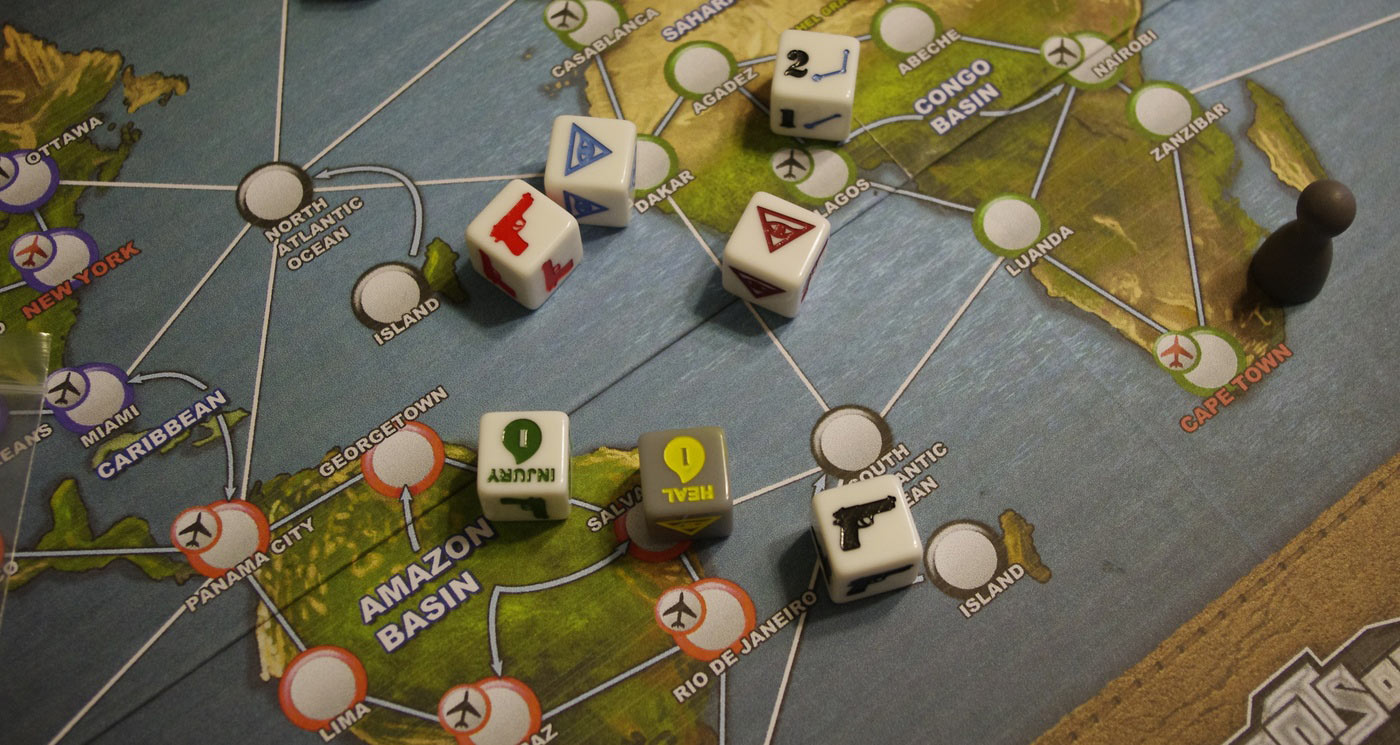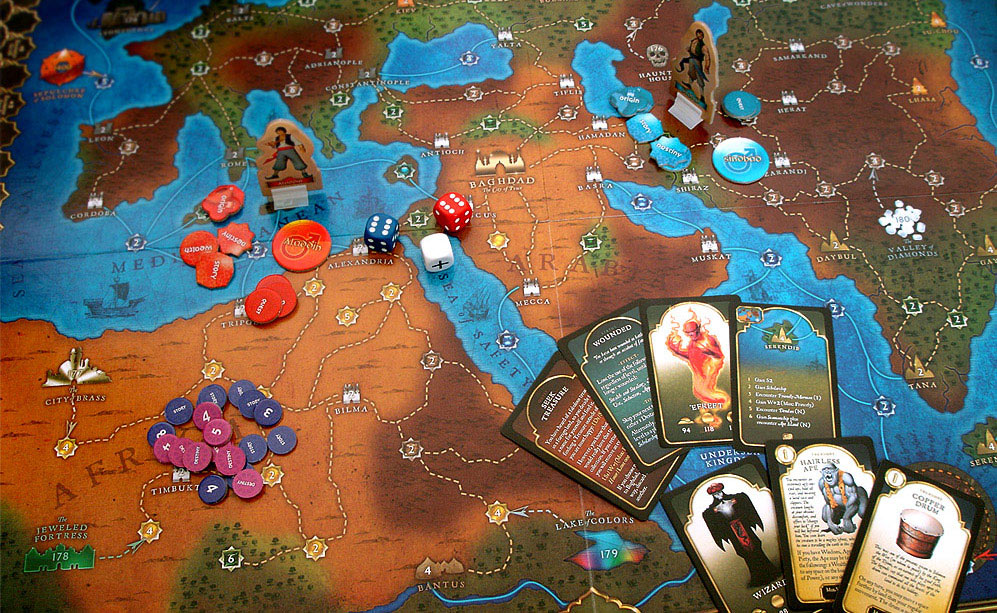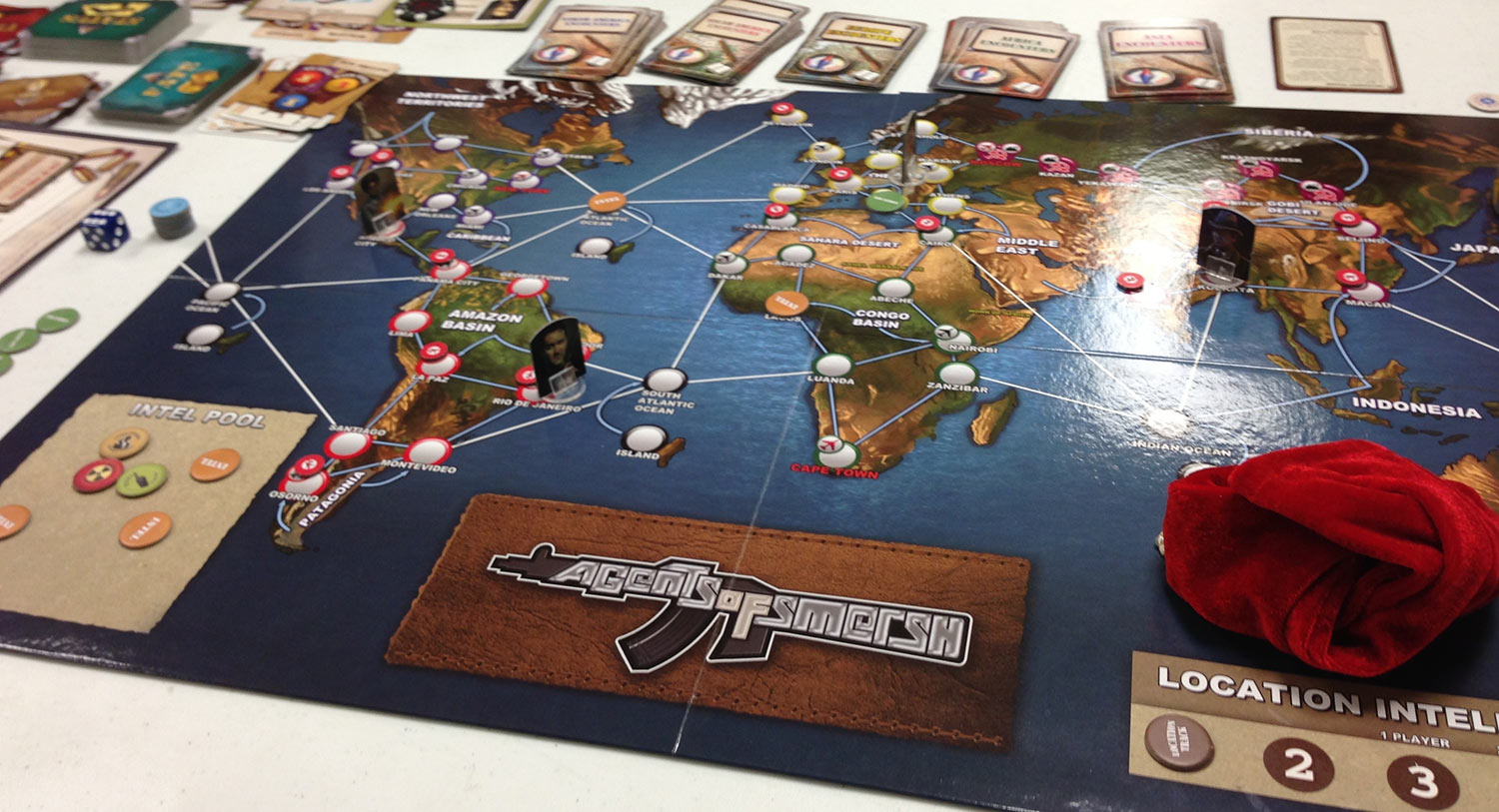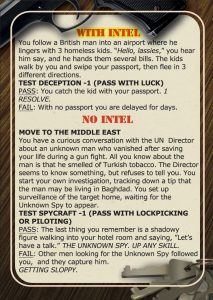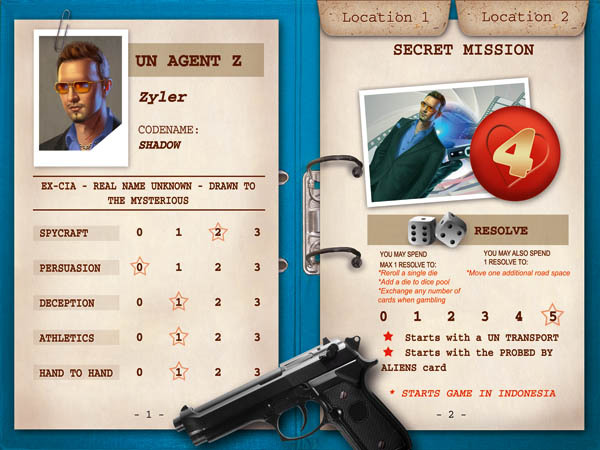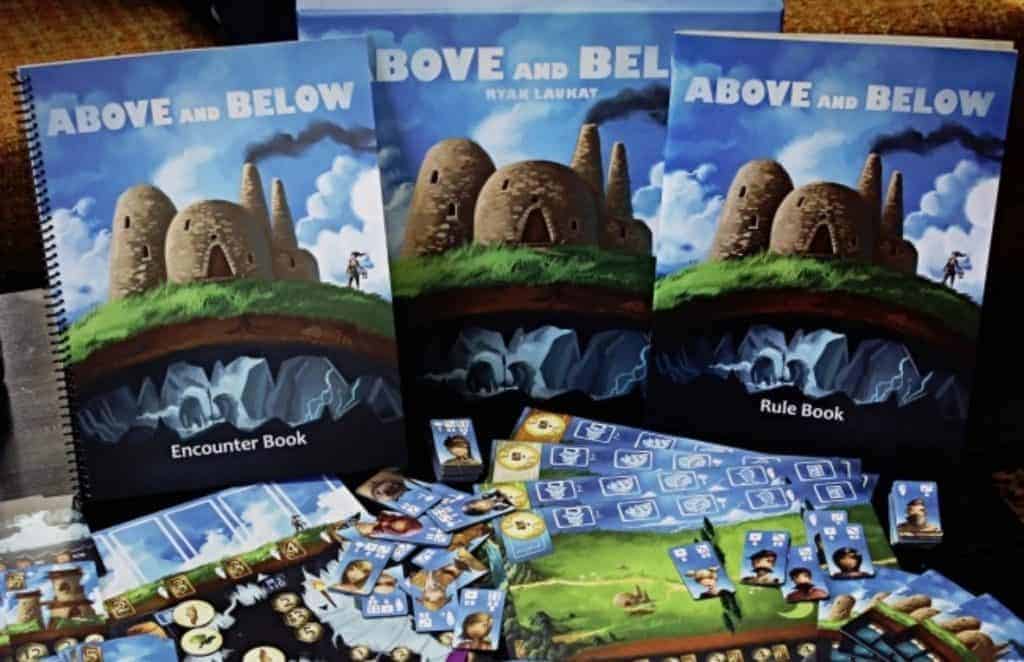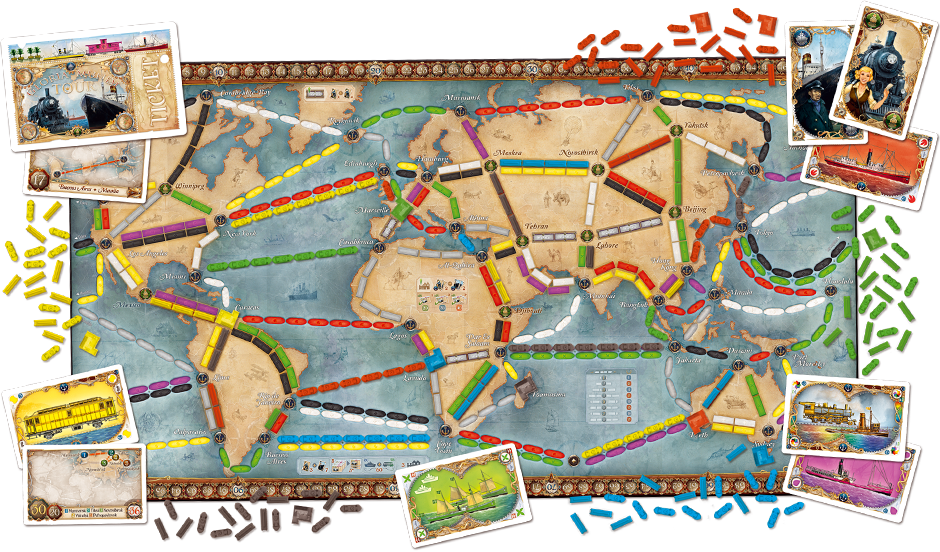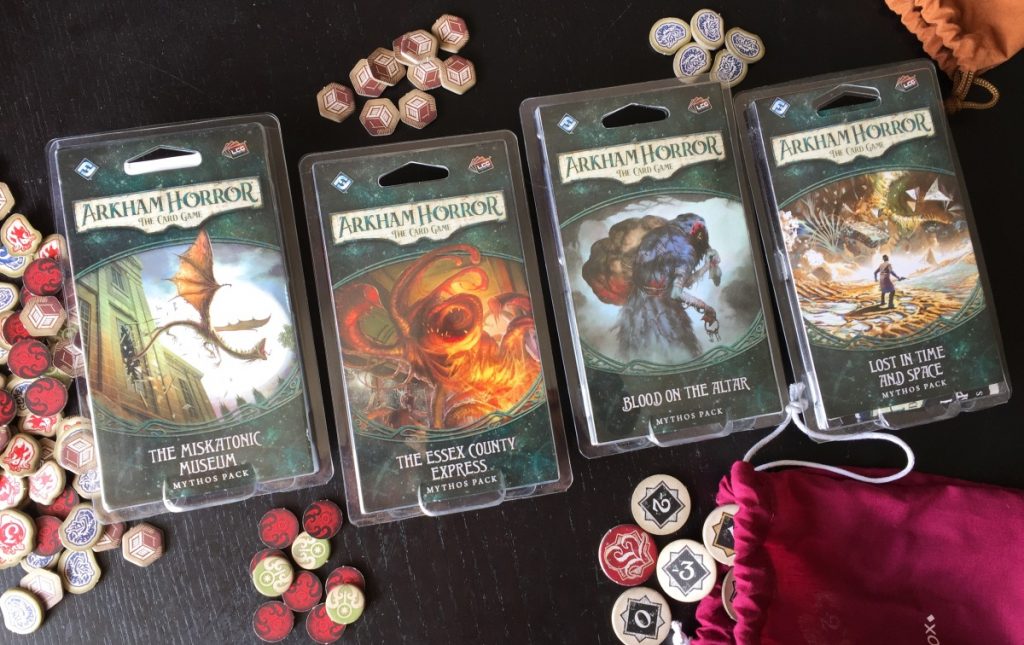[Shut Up & Sit Down is immensely proud to present the following review of Agents of Smersh, a story game, by James Wallis, story game designer. James is the wonderful mind behind Once Upon a Time, and the actually-extraordinary Extraordinary Adventures of Baron Munchausen. He’s also a lovely man. Enjoy!]
James: Agents of Smersh is a cooperative board-game for 1–4 players although it can be played by five if you want, and there’s part of its problem right there. The other problem is that Agents of Smersh is one of those children, like Carol Thatcher or Chelsea Clinton, whose parent is so dominant that it can never get away from them to build its own identity no matter how hard it tries.
What is Agents of Smersh? Agents of Smersh is Tales of the Arabian Nights given a rework and a re-skin. And at this point you are either looking slightly quizzical—’Tales of the Arabian Nights, is it that… oh I remember, Paul and Quinns reviewed it here, they dressed up, it was funny, I think they liked it quite a bit’—or you have just wet yourself with excitement. To understand Agents of Smersh it is important that you understand Tales first, so either read on or skip the next six paragraphs while you change your pants.
Tales of the Arabian Nights is a game that divides people. It’s a narrative board-game, perhaps the first narrative board-game and definitely the first narrative board-game that matters. Designed by Eric Goldberg with input from Doug Kaufman, Ken Rolston and Greg Costikyan, Tales was released by West End Games in 1985, the moment when it was the most exciting and original games company in the world. It’s a game of having adventures in the world of Scheherezade’s stories, and is based on an enormously complicated system of encounter-resolution matrices and the Book of Tales, which is what Fighting Fantasy books want to be when they grow up. The original Book of Tales had 1300 different stories in it, most with multiple possible outcomes. The 2009 edition from Z-Man Games has 2600 stories.
Tales is an awesomely fun game, but it is flawed. It has a gorgeous map as a board, but no real reason to be exploring it or to head for any destination in particular. Encounters are arbitrary, and each character has a dazzling, often confusing array of skills and statuses, all of which affect stuff. There’s very little player interaction. At its heart there is no strategy: you just move, draw cards and let the game happen to you. But it all works so, so well. The last time I played, I spent most of the game Scorned, then went On Pilgrimage to get rid of the Scorned status, and while still on pilgrimage I became Scorned again. People made fortunes and lost fortunes, sometimes in the same turn. The winner was a monkey on a flying carpet: he hadn’t started out as either of those things, but that’s the way Tales goes. If you like games where it doesn’t matter who wins as long as everyone laughs a lot, you need a copy.
It’s not a BoardGameGeek type of game, is what I’m saying. Too much randomness, too much silliness, too many Magyan Fire-Worshippers and sex-change springs for that crowd.
To understand how it works, here is a typical turn, written without reference to the actual board-game because I am on a train. Bear with me, this is important.
Player 1: I’m in Timbuktu. Okay, I draw a card and I have encountered… a djinn. It says table 45.
Player 2: (consulting the Book of Tales) It’s a vengeful djinn, on Matrix E.
Player 3: (consulting Matrix E) You can question the djinn, bribe him, hire him, seduce him, fight him or
follow him.
Player 1: I have the Trading skill, so let’s try to hire him.
Player 3: (consulting the Matrices) That’s paragraph 1541.
Player 1: (rolls d6) I got a 2, so it’s 1540.
Player 2: (looks up paragraph 1540 in the Book of Tales) ‘A friend desires to be protected against a remorseless foe, and you arrange a contract between him and a fierce individual you know. Alas, when they meet it turns out that your hireling is the foe in question.’ Do you have the Diplomacy skill?
Player 1: I have Seduction?
Player 2: Doesn’t help. ‘Your friend is slain and you are chased from his house. Gain one Destiny point, one Story point and the Exiled status.’
That’s the gist of it: loads of mechanics that were excitingly complex in the 1980s but these days are crying out for a nice little app to handle them—it exists—and story outcomes that will leave you penniless and scorned in a gutter in Carthage. It’s not Ameritrash, it’s not a Eurogame, it’s a sui generis sine qua non. And either this is so much your idea of fun that you have literally played your original copy of the game to destruction, or you would much rather be reading about the latest expansion to Trainy Train Training Time. No prizes for guessing which describes me.
But it’s not entirely sui generis. There have been imitators. West End Games stripped the system down to create Star Trek: the Adventure Game (1985). Mayfair released a Lone Wolf and Cub game in 1989 (designed by Matthew J Costello), more recognisably based on that than on Tales but with a book of tales that had less than fifty paragraphs and rules so badly printed that it was literally unplayable: it is deservedly forgotten. And now there’s Agents of Smersh, which this review is supposed to be about.
ACTUALLY TALKING ABOUT THE GAME NOW
Agents of Smersh (designed by Jason Maxwell) was kickstarted in early 2012 and released in late 2012. It’s a big, lavish box full of good-looking components—not as good-looking as Tales, which was designed by the amazing Peter Gifford (admission: Peter and I share an Origins Award for the graphic design of Nobilis 2e (Hogshead, 2001)), but still very nice indeed. Big board with a map of the world, character sheets for the player characters, decks of encounter cards, matrices, an enormous book of tales (here called the Book of Encounters) with 1600 mini-scenarios on it. The whole box, everything in it, is a massive love-letter to Tales. It never admits it of course, the publishers are probably afraid of being sued, but its teenage crush is blatant and really quite sweet.
But even its greatest fans admit that Tales has flaws—I did in paragraph four—and Agents sets out to fix them. For a start the game is cooperative: you all play Bond-style UN secret agents working together to defeat the nefarious Doctor Lobo and his henchmen, which makes sense given that Tales was nominally competitive but had almost no pvp elements. And now there’s a reason to actually do things: you’re trying to gather intel on the doctor’s activities, aiming to uncover all his schemes before he reaches the end of his villain track and takes over/destroys the world.
You’re literally gathering intel: intel chips appear around the map and you have to go and pick them up. Along the way, you have encounters, which resolve almost exactly like the ones in Tales, except not quite. The designer has tried to simplify the system of matrices and paragraphs, and has partly succeeded. Instead of a single deck of Encounter cards there are different ones for each continent, which makes sense. What doesn’t make sense is the way the whole thing is phrased.
Player 1: I’m in Santiago so I draw a South American encounter card. ‘Take a Chance’, it says.
Player 2: What does that mean?
Player 1: I’m not sure. It’s on Response Group E, anyway.
Player 3: (consulting the Group Reaction Sheet) Your choices are, uh… ‘Take charge’, ‘I’d rather be lucky…’, ‘Unorthodox’, ‘Frighten’, ‘Joke’ or ‘Trust no one’.
Player 1: I don’t see how those fit with ‘Take a chance’ and I have no idea what is about to happen. But since I have a high Persuasion skill, I’ll go with ‘Frighten’.
Player 3: So that’s the number from the card—21—and the number from Frighten, which is 4, and you need to draw a Fate card. There’s no intel chip on Santiago, so use the ‘No Intel’ number on the card.
Player 1: It’s 1.
Player 3: Paragraph 21.4.1
Player 2: (turns to the paragraph in the Encounter Book and reads out a long encounter about trying to intimidate an informant.)
It looks like it ought to be simpler, but in fact it’s more clunky in play, and much of the time the obtuse phrases mean you have no idea what the encounter is going to be, or what your choices mean. And this is the problem I referred to in the first line of this review: Agents wants to have its cake and eat it: it wants to capture the nutty story-telling fun of Tales but it wants to improve on it as well, streamlining the 1980s mechanics and making them more 2010-ish, to create something that’s more of an actual game. And it ends up failing somewhere between the two.
Characters in Agents are no longer a mess of skills and statuses, instead they have five attributes that go up and down, plus Resolve (Energy) and Wounds, which really could have been the same stat. But then there are skills and statuses and equipment and advanced skills that you get from cards, which end up being just as complicated to remember as the ones in Tales.
Intel gives you a reason to explore the board, but there isn’t much you can do with it except put it unexamined into a pool, which you will eventually use to work out if you’ve won or lost. The whole intel mechanic doesn’t really work: the core idea is sound but it’s festooned with extra rules and conditions to make it functional. This ends up being over-complex and fiddly, and doesn’t fit the game’s metaphor. Having all the intel on the board vanish if the number of counters passes an arbitrary amount makes sense for gameplay, but not narratively—and Agents is above all a narrative game.
And then there’s the Henchmen mechanic. Doctor Lobo has four helpers, and you can only get to the endgame the game by tracking them down and beating them a certain number of times. This is a pretty sweet idea but the game doesn’t make enough of them—they’re passive, they exist only to be beaten up, they don’t move on their own or have objectives of their own. They’re literally cardboard, and that’s a real shame.
And for all its added-in gaminess, Agents’ gameplay ends up being just as random and arbitrary as Tales was. Players are cooperating but the chances for their characters to work together are just as few as the opportunities in Tales for characters to beat up on each other. There’s more dice-rolling than Tales ever had, and the mechanic of gathering intel on Doctor Lobo without knowing what that intel is until the end feels like trying to win Cluedo by throwing darts at suspects.
There are a couple of lessons for game designers here. First of all, you can’t redesign individual parts of a game without expecting that to have knock-on effects to the rest of the game, mechanically and tonally. Game design is a holistic process, it’s not about having a few ideas and bolting them to an existing structure. And secondly, adding more complexity to a thing does not make it better. Characters in Agents are more complex than the ones in Tales without being better. The dice mechanic is over-complex and unnecessary. The mechanic for closing airports is superfluous. The game needed an editor.
And speaking of editors there’s the rulebook, which is… put it this way, there’s a rewritten version available as a free PDF here [http://boardgamegeek.com/filepage/91647/new-official-rules-version-2-0] and you should use that.
Why do I insist on reviewing Agents of Smersh as if it was a sequel to Tales of the Arabian Nights? Because that’s what it is, and because that’s the context in which it’s most interesting. Taken on its own, as a story-telling board-game about spies who are sometimes straight and sometimes cartoony, it’s a perfectly good evening’s entertainment. But the solid core that makes the game work is entirely second-hand, and the rest of it doesn’t quite gel.
I’m being hard on it. It is fun. If Tales of the Arabian Nights didn’t exist then this would be an excellent narrative board-game, but if Tales didn’t exist then Agents of Smersh wouldn’t exist either. And while in terms of its mechanics Agents may be a better game than Tales, as an entertaining experience it can’t pull together the resources it needed to overcome its old foe from the Middle East.
Rating: 007/10

